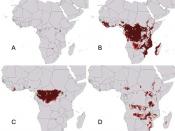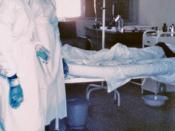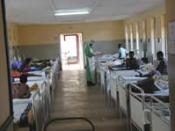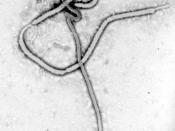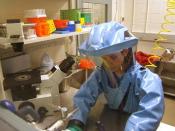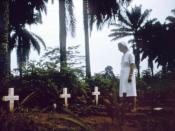Ebola hemorrhagic fever (Ebola HF) is a severe, and often fatal disease in humans and in primates that has accure irregularly since its discovery in 1976. The Ebola virus is named after a river in the Democratic Republic of the Congo in Africa, where it was first discovered. The virus is one of two members of the family of RNA viruses called the Filvoridae. There are four types of the Ebola virus, but only three of the four, cause disease in humans: Ebola-Zaire, Ebola-Sudan and Ebola-Ivory Coast. The fourth, Ebola Reston, only causes disease in primates. The virus is a level four pathogen (witch is higher than aids) Viral hemorrhagic fevers are caused by viruses from four families: filoviruses, arena viruses, flaviviruses, and bunya viruses. The usual hosts for most of these viruses are rodents or arthropods (such as ticks and mosquitoes). In some cases, the natural host for the virus is not known.
Confirmed cases of the virus have been reported in the Democratic Republic, Gabon, Sudan, the Ivory Coast, and Uganda. No case of the deseas has been reported in the United States. Some researchers became infected with the virus but never became ill.
The manner in which the virus first appears in a human at the start of an outbreak has not been determined, but researchers think that the first person becomes infected through contact with an infected animal. Symptoms of the Ebola virus begin four to sixteen days after the person has been infected. The incubation period for the Virus ranges from two to twenty one days. Within a week, a raised rash appears over the entire body; the rash is often Hemorrigic. Hemorrhaging generally occurs from the gastrointestinal tract, causing the patient to bleed from both the mouth and rectum. Beginning symptoms are headaches, breathing problems, fevers, red eyes, hiccups, chills, muscle aches, loss of appetite and shock. As the disease progress, patients experience diarrhea, rash, sore throat, vomiting, and abdominal and chest pain. The patients have little kidney and liver functions, and have internal and external bleeding. Their blood does not clot which can cause some serious problems, like causing the capillaries to bleed into surrounding tissue. Later symptoms are; eye inflammation, depression, increased sense of pain in the skin, and bleeding from the eyes, ears and nose. The death of a patient occurs.
Diagnosing the Ebola virus in a person who has been infected only a few days is difficult because the early symptoms, such as red eyes and a skin rash are non-specific to the virus and are seen in other patients with diseases that occur much more frequently. But if the person has all of the symptoms, and infection with the Ebola virus, are suspected. Researchers don't understand why some people are able to recover from the virus and others are not. It is known that the patients who die usually have not developed a significant immune response to it at the time of death.
The virus can easily spread through several ways. People can be exposed to it from direct contact with infected blood or secretions. So the virus is often spread through family and friends because they come in such contact with secretions when caring for an infected person. People can also get it through contact with objects, such as needles. Nosocomial transmition is when the spread of the disease happens within a health care setting, like a clinic or a hospital. That happens in African health care places when patients are treated without masks, gowns, or gloves. It can also be spread through organs, and semen of an infected person. The virus can be spread through infected needles that are reused. In Virginia one of the four viruses had been transmitted from one monkey to another through the air. All Ebola viruses have displayed the ability to be spread through the air under research conditions, this type of spread has not been done among humans in a real world setting.
An infected persons vomit or diarrhea, are filled with blood and mucus with the virus in it. Any person that comes in close physical contact with it should be under close surveillance. It can also be spread through sexual contact with an infected person. Suspected cases should be isolated from other patients and strict barrier nursing techniques practised. Recovered patients do not pose a serious threat of infecting another person. But the virus may not be present in a human's body seven weeks after being treated. Even if a patient with Ebola dies, it's important that direct contact with the body of the deceased patient be prevented.
So far, there is no standard treatment for the Ebola virus. Currently, Patients receive therapy. This consists of balancing the patient's fluids and electrolytes, maintaining their oxygen status and blood pressure, and treating them for any complicating infections. Diagnosis requires specialized laboratory tests on blood specimens. Handling blood from persons infected with Ebola virus is an extreme biohazard and can be done only in specially equipped laboratories. Testing tissue samples can make diagnosis in patients who have died.
Until recently, only three outbreaks of Ebola hemorrhagic fever in humans had been reported. The first two, in 1976 in Zaire and in western Sudan, were large outbreaks that resulted in more than 550 cases and 340 deaths. The third outbreak, in 1979 in Sudan, was smaller, with 34 cases and 22 deaths. In each of these outbreaks, most cases occurred in hospitals where medical supplies were inadequate and where needles and syringes were re-used. Isolating sick patients in a place requiring the wearing of mask, gown, and gloves; sterilizing needles and syringes; and disposing of wastes and corpses in a sanitary way quickly controlled the outbreaks.In 1995, an outbreak in Kikwit and surrounding areas in Bandundu Province, Zaire, caused 316 deaths. The outbreak was amplified in a hospital by staff that became infected through poor nursing techniques. At the request of health officials in Zaire, medical teams from CDC and the World Health Organization, and from Belgium, France, and South Africa, collaborated to investigate and control the outbreak. Two isolated cases of Ebola hemorrhagic fever were identified in Cote d'Ivoire in 1994-1995. The most recent outbreaks were in rural Gabon in 1994 and in 1996. A patient from the 1996 Gabon outbreak traveled to Johannesburg, South Africa, and fatally infected a health-worker there as well.
The prevention of Ebola in Africa presents many challenges, because the location of the natural place the disease comes from is unknown. There are a few established primary prevention measures. If the case does appear, Economic condition promote the spread of the virus, health care providers must be able to recognize a case of ebola when it appears
